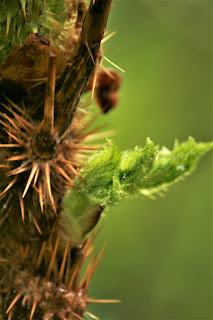These are just the biggest and most obvious of the spines that cover this plant. These are woody spines found on the stem of the plant which rarely break off into your skin, just puncture it like needles. There are also smaller, more delicate spines that do penetrate the skin where they then break off and lie in wait to cause you pain and discomfort many hours and days later. Every part of this plant, the woody stem, the leaf stalks, and the leaves themselves have spines that hurt, except the roots, they are the only spineless part of the plant. This is the cactus of the rainforest.
I have honestly become very fond of this plant, to me it represents just how rugged, wild, and difficult this part of the world is. Devil's Club grows in more open areas where the sunlight can actually penetrate the forest canopy and can grow to over 10' tall while never getting any bigger in diameter than a half dollar. This results in a plant with a long stem with a lot of spring and given the fact that Devil's Club tends to grow in fairly dense thickets, it has a sinister tendency to smack you on some part of your body when you least expect it, step on one stem and another one that you didn't notice will whack you across your T-shirt clad back! Devil's Club is also very good at being the only available usable handhold when you are climbing a steep forested slope and only the thickest of leather gloves can armor your hands against its woody spines. The softer, more delicate spines can actually be much worse than the big, obvious ones. You usually don't feel them enter you and only realize they are there hours later when you feel a sharp, piercing pain. These things get in deep somehow and are nearly impossible to extract unless you know the proper technique which I will share with you so that you know what to do should you ever encounter this plant. The proper technique for removing these insidious little things is to suck it up and deal with their discomfort for 2-3 days until they begin to fester slightly then you can easily squeeze them out. For real. This is what I have found to be the best anyway and it gives me great and sadistic pleasure when those little hairlike spines pop up out of my skin.
I started that paragraph by stating that I was fond of Devil's Club didn't I? I truly am which may give some disturbing insight into my personality. I have hiked so many miles in this jungle now that only the densest of Devil's Club thickets makes me alter my course and I carry my Devil's Club spines and scars as a badge of timber beast pride! And, picking out those little spines over the next several days gives a person something to do if you get bored!
I may have given a bad first impression of Devil's Club but it is also a beautiful plant as you can see from the above photo of a fully grown leaf. The leaves can get quite large and have a very attractive symmetry somewhat like a maple leaf. I have always thought that some sort of Devil's Club leaf design would make a cool tattoo. Devil's Club may be so well armored and protected due to its wealth and value as a medicine and food source. Devil's Club is related to ginseng and has been used for centuries to treat a wide variety of medical issues like arthritis, rheumatism, diabetes, dandruff, digestive issues, menstruation issues, colds, tuberculosis, and many other things. It is used as a tea, poultice, and salve. Putting a Devil's Club stem above your doorway is also supposed to keep evil spirits from entering your house and seems to work as I have not had a single evil spirit in my house since putting it above my door. The plant also has pretty red berries later in the year which are also edible and are an important food source for some animals especially bears. Devil's Club also has a very distinctive and pleasant smell. This plant is truly, truly a natural wonder.





















































